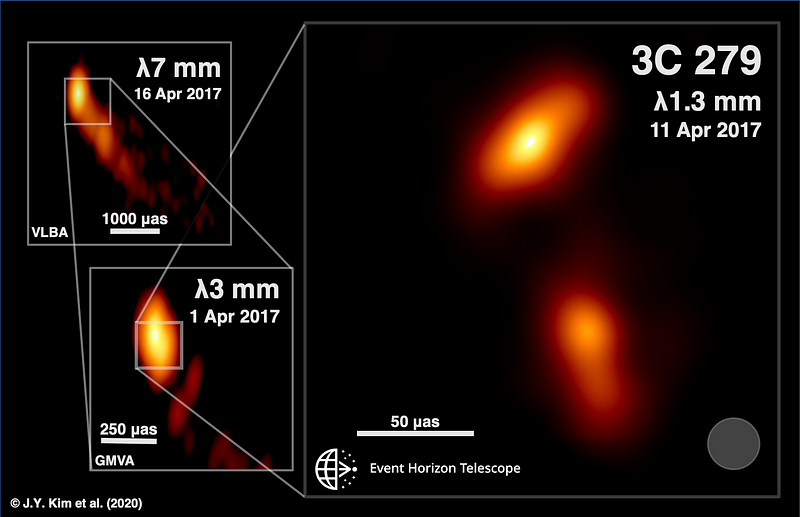Exploring the Mysteries of Quasar Jets in 3C 279
Written on
Chapter 1: Introduction to Quasar 3C 279
Quasar 3C 279 has been observed with remarkable clarity, unveiling a tumultuous past. The jets emitted from this quasar, captured by the Earth Horizon Telescope (EHT), illustrate the galactic dynamics with striking detail. These jets, composed of massive gas streams, are propelled away from 3C 279 at velocities nearing the speed of light, indicating a history marked by violent events.
In 2019, the EHT—a collective of radio telescopes—unveiled the first image of a black hole's vicinity. Now, researchers have redirected their focus to 3C 279, a fascinating quasar.

The initial detailed observations of quasar jets, specifically from 3C 279, have been made possible through the EHT. Led by Jae-Young Kim from the Max Planck Institute for Radio Astronomy (MPIfR) in Bonn, a study traced the jet back to its source, revealing significant fluctuations in radiation across various frequencies.
Quasars are distant galaxies powered by supermassive black holes that consume immense amounts of gas. This accretion generates substantial radiation output. Under specific conditions, these black holes can produce jets that accelerate away from their origins, guided by powerful magnetic fields.
Researchers noted, "The formation, acceleration, collimation, and propagation of relativistic jets in active galactic nuclei (AGN) stem from the vicinity of a supermassive black hole located at the galaxy's center. Understanding these processes is a central goal in modern astrophysics."
The supermassive black hole at the core of 3C 279 boasts a mass equivalent to a billion suns and lies approximately five billion light years from Earth, within the Virgo constellation. The jets from this black hole extend outward at nearly light speed.

Chapter 2: The EHT and Its Observational Techniques
The EHT employs a method known as very long baseline interferometry (VLBI), which integrates signals from radio telescopes worldwide. This collaboration allows astronomers to achieve a level of detail comparable to seeing an orange on the Moon.
Data collected by the EHT is processed at the Max Planck Institute for Radio Astronomy and MIT’s Haystack Observatory, subsequently analyzed by a global network of researchers. Observing 3C 279 from a distance of five billion light years enables astronomers to discern features just one light year across, a quarter of the distance to our nearest stellar neighbor. This extraordinary detail has allowed scientists to trace the jets back to their origins, where they observed an unexpected structure radiating outward perpendicular to the main jets, possibly linked to the poles of the disk surrounding the black hole.
Jae-Young Kim remarked, "Every time we explore a new perspective of the Universe, we discover something novel. Here, where we anticipated clarity in jet formation, we encountered an entirely different configuration, akin to finding an unusual shape in a tiny Matryoshka doll."
For the first time, astronomers have witnessed the movement and variations of these jets over days, likely resulting from material spiraling into the black hole and the disk's rotation. While such dynamics have been predicted through simulations, this is the first time they have been observed in reality.
This video provides a visual representation of the 3C 279 quasar jet and its observed motion over a week, captured by the EHT in April 2017, showcasing the intricate dynamics at play.
Chapter 3: Insights into Jet Dynamics
Avery Broderick, an astrophysicist at the Perimeter Institute, expressed, "The combination of the EHT's groundbreaking resolution and new computational methods has been transformative. What was once considered a singular radio 'core' has been resolved into two distinct complexes, exhibiting movement even across light-month scales. The jet in 3C 279 is advancing towards us at over 99.5% of the speed of light!"
Initially, these jets appear to challenge the laws of physics. Due to an optical illusion, they seem to travel away from the quasar at speeds 20 times greater than light—far exceeding the Universe's speed limit. This phenomenon occurs as material approaches us, "chasing" the light it emits, creating the false impression of superluminal speeds. These conditions could indicate the presence of shock patterns or instabilities in the bending, rotating jets, potentially explaining the high-energy electromagnetic emissions, including gamma rays, resulting from these outbursts.
James Maynard, the founder of The Cosmic Companion, resides in Tucson, Arizona, with his wife Nicole and their cat, Max.
Did you enjoy this article? Join us at The Cosmic Companion Network for our podcast, weekly video series, informative newsletter, and news briefings on Amazon Alexa and more!
Chapter 4: The Recipe for Powerful Quasar Jets
The second video dives into the mechanisms behind the formation of powerful quasar jets, discussing the critical processes and conditions that allow these jets to manifest.
This video offers a tour of the essential factors contributing to the formation of powerful quasar jets, enhancing our understanding of these cosmic phenomena.